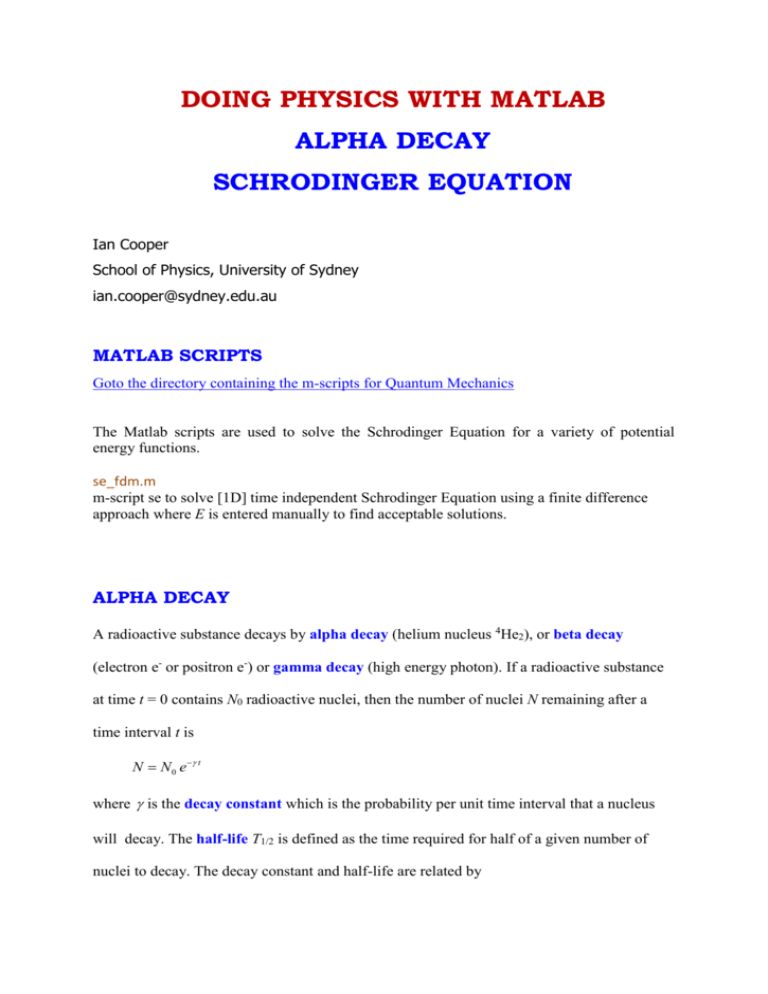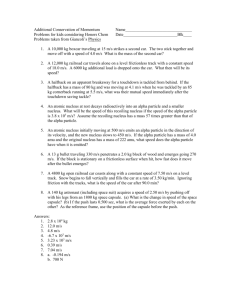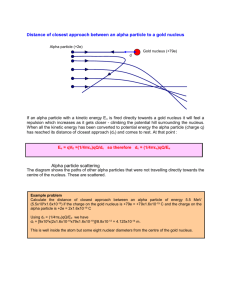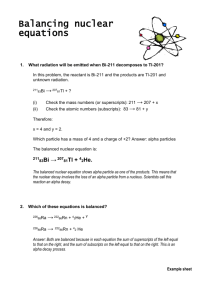alpha_decay - School of Physics
advertisement

DOING PHYSICS WITH MATLAB ALPHA DECAY SCHRODINGER EQUATION Ian Cooper School of Physics, University of Sydney ian.cooper@sydney.edu.au MATLAB SCRIPTS Goto the directory containing the m-scripts for Quantum Mechanics The Matlab scripts are used to solve the Schrodinger Equation for a variety of potential energy functions. se_fdm.m m-script se to solve [1D] time independent Schrodinger Equation using a finite difference approach where E is entered manually to find acceptable solutions. ALPHA DECAY A radioactive substance decays by alpha decay (helium nucleus 4He2), or beta decay (electron e- or positron e-) or gamma decay (high energy photon). If a radioactive substance at time t = 0 contains N0 radioactive nuclei, then the number of nuclei N remaining after a time interval t is N N 0 e t where is the decay constant which is the probability per unit time interval that a nucleus will decay. The half-life T1/2 is defined as the time required for half of a given number of nuclei to decay. The decay constant and half-life are related by t1/2 ln 2 In alpha decay, a nucleus emits a helium nucleus 4He2 which consists of 2 protons and 2 neutrons. Therefore, the atomic number Z decreases by 2 and the mass number A decreases by 4. If X is the parent nucleus and Y is the daughter nucleus then the decay can be written as A X Z A 4 YZ 2 4 He 2 The attractive forces binding the nucleons together within the nucleus are of short range and the total binding force is approximately proportional to its mass number A. The repulsive electrostatic force between the protons is of unlimited range and the disruptive force in a nucleus is approximately proportional to the square of the atomic number. Nuclei with A > 210 are so large that the short range force barely balances the mutual repulsion of their protons. Alpha decay occurs in such nuclei as a means of reducing their size and increase the stability of the resulting nuclei after the decay has occurred. A simple model for the potential energy of the alpha particle as a function of distance r from the centre of the heavy nucleus is shown in Figure (1). The potential well is modelled as a three dimensional deep attractive well associated with the strong nuclear force and beyond the range of this force an electrostatic repulsion due to the Coulomb force between the daughter nucleus and the alpha particle of the form U (r ) 2 Z 2 e2 4 0 r where r is the distance from the centre of the nucleus and Z is the atomic number of the parent and (Z-2) the atomic number of the daughter nucleus. U(r) coulomb repulsion U ~ 1/r kinetic energy of ejected alpha particle K = E E E 0 K R0 R1 U(R1 ) = E K = 0 U parent -U0 E=U+ K AX Z r 2 Z 2 e2 R1 4 0 E daughter A-4 X Z-2 4 He particle 2 R0 1.07 ( A 4)1/3 41/3 fm Fig. 1. The potential energy of an alpha particle as a function of the distance from the centre of the nucleus. From a classical point of view, an alpha particle does not have sufficient energy to escape from the potential well. The barrier height is typically in the order of 30 MeV and the decayed alpha particles have energies only in the range 4 to 9 MeV. This range of energies from 4 to 9 MeV is very small, but the half-lifes of the radioactive alpha emitters range from ~10-7 s to ~1018 s, while the energy changes by a factor of 2, the change in the half-lifes is ~25 orders of magnitude !!!. Our goal is explain, how an alpha particle can escape from a nucleus and find a relationship between the energy of the alpha particle and its half-life. We will do this by analytical means and by solving the Schrodinger equation numerically for an alpha particle in a potential well as shown in Figure (1). Classical arguments fail to account for alpha decay, but quantum mechanics provides a straight forward explanation based upon the concept of tunnelling where a particle can be found in a classically forbidden region. The theory of alpha decay was developed in 1928 by Gamow, Gurney and Condon and provided confirmation of the power of quantum mechanics. We will develop simplified models to account for alpha decay and compare or predictions with those of experiments. ANALYTICAL MODEL Assume that an alpha particle exists as a particle in constant motion with velocity v contained inside the heavy nucleus by a surrounding potential barrier. There is a small probability that the alpha particle can escape each time it encounters the barrier. The decay constant gives the decay probability per unit time fP where f is the number of times per second an alpha particle strikes the potential surrounding it and P is the probability that the particle passes through the barrier. Assume that the alpha particle moves back and forth in the nucleus of radius R0 . We can estimate the radius R0 assuming that it is equal to the radius of the alpha particle and the daughter nucleus (Figure (1)) R0 1.07 41/3 ( A 4)1/3 fm where A is the mass number of the parent nucleus. Then the frequency f of striking the barrier is f v 2 R0 where v is the alpha particle on escaping from the nucleus. For the barrier region, U > E and K < 0, classical physics predicts a transmission probability P = 0. However, in the quantum picture, the particle behaves as a wave and there is a non-zero probability of the particle escaping from the potential well, P > 0. The particle escapes the barrier when U = E at the position R1 where R1 2 Z 2 e2 4 0 E where E is the final kinetic energy of the escaped alpha particle. After much “hard work” it can be shown that the probability of an alpha particle escaping our potential well is 1/2 2 m E 1/2 R0 P exp 2 2 R1 2 2 R1 Hence, we can find a relationship that predicts the half-life given the energy of the escaped alpha particle ln t1/2 ln(ln 2) ln vP v 2 E m ln t1/2 ln(ln 2) ln v ln P ln t1/2 2 E ln(ln 2) ln m 1/2 2 m E 1/2 R0 2 2 R1 2 2 R1 http://hyperphysics.phy-astr.gsu.edu/hbase/nuclear/alptun2.html http://www.wolframalpha.com/input/?i=polonium208








